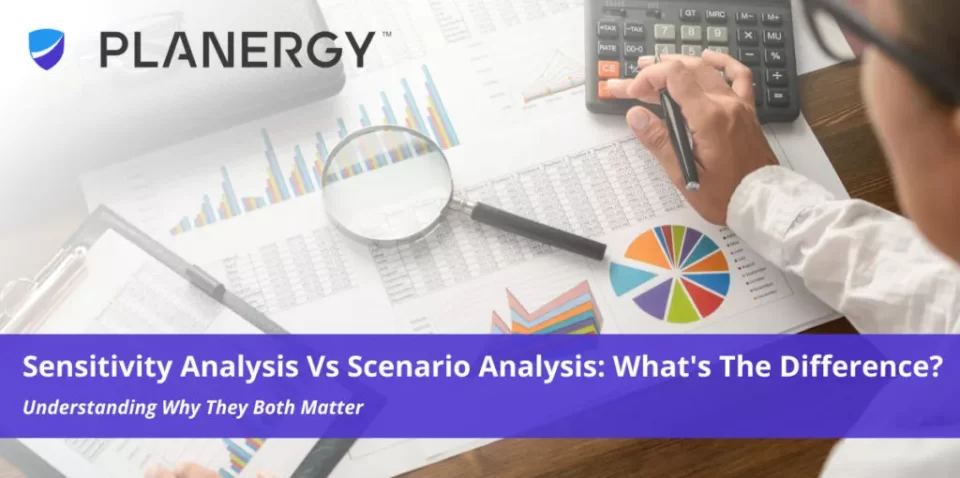Sensitivity Analysis vs Scenario Analysis: What’s The Difference?
Sensitivity analysis and scenario analysis are methods of assessing risk. Before making an investment, organizations can use sensitivity analysis and scenario analysis to determine the risks they’re willing to take.
These methods are crucial to businesses because as we know, the only thing we can count on for sure is that nothing is certain.
Scenario analysis and sensitivity analysis are analytical methods to help investors determine the amount of risk and their potential benefits. The difference between the two is that sensitivity analysis examines the effect of changing a single variable at a time.
Scenario analysis assesses the effect of changing all of the variables at the same time.
What is Scenario Analysis?
Scenario analysis involves analyzing the movement of a specific valuation or metric under different scenarios.
For instance:
- What happens if the prime rate goes up?
- What if candidate A wins the election? What if candidate B wins the election?
- What if competitor A releases a new piece of technology? What if competitor B beats us to market?
- What if currency C strengthens?
With scenario analysis, you predict the value of a future investment based on changes that may occur to your existing variables. You have to explore the impact of different market conditions on the investment or the project as a whole.
Using scenario analysis, you have a rational and structured way to analyze the future. Your organization can use it to examine the potential impacts of both negative and positive events.
With scenario analysis, you’re not a damn thing to predict a single outcome from any event. Rather, you’re looking at a spectrum of potential situations and outcomes generally ranging from a best-case to worst-case scenario.
The base-case scenario is a baseline scenario based on your current and commonly accepted assumptions. Your worst-case scenario is all of the most negative assumptions. Your best-case scenario is your ideal projected scenario required to achieve your objectives and goals.
Scenario analysis was started in the mid-1980s by the US Military. Shell Oil began using it in the 1970s to analyze and respond to fluctuations in the global oil supply. Now, businesses use it widely thanks in part to financial modeling tools that remove the majority of the manual effort it takes.
Scenario analysis is crucial for small businesses as smaller companies may be more heavily affected by a single event. Scenario analysis is used by financial services companies to analyze risk and make investment decisions, but you can also use it to analyze your household finances.
Scenario analysis considers the potential event and the business scenario resume results. For each scenario, the organization makes assumptions about its effect on different factors that are important to the business such as the cost of raw materials or interest rates. The assumptions are then used as input variables to model the impact of each scenario on the business.
Generally, the scenario analysis considers different factors. For example, analyzing the potential financial impact of building a new facility may consider utilities, rent, labor, taxes, and other fees, for instance.
Let’s assume that company X makes laundry equipment. They come up with an idea for a new appliance that folds laundry after it comes out of the dryer. But, it will take at least 12 months to get the product to market and financial analysts are predicting worsening economic conditions.
Company X could use scenario analysis to look at the potential impacts of economic conditions on the revenue and profit generated by the new laundry folding machine. Economic conditions may impact a variety of factors from the cost of raw materials to customer demand. Company X could consider a wide range of scenarios, each of them generating a different set of assumptions.
In one situation, sales may fall by 30% because customer demand declines as a result of economic conditions. The cost of raw material rises because some suppliers go out of business and there’s less competition among those left. However, rent on manufacturing facilities could easily fall by 15 percent and the company may be able to borrow money at a lower interest rate to fund their manufacturing start-up costs. Scenario analysis could consider the impact of all of these factors.
Scenario Planning
Based on your findings, you can then conduct scenario planning to better prepare for these events and their potential impact.
Scenario planning helps decision-makers have a plan of action in the event that any of your possible situations do become reality for the company.
In scenario planning, you take the specific scenarios you developed in analysis and make assumptions based on how your business may change in the future if those assumptions become your reality.
For instance, if you find that economic conditions change and cash flow dramatically decreases, you can create a plan of action that involves taking a working capital loan to keep operations running as smoothly as possible.
This way, if and when the financial model becomes reality, you know exactly what you’re going to do. You’ll reach out to a working capital lender like PayPal, that will base your loan on your sales – rather than your credit score.
Benefits of Scenario Analysis
Scenario analysis offers many benefits to organizations including:
- More proactive risk management by assessing the impact of potential situations
- Better decision-making as a result of investigating the benefits and risks of various options
- A methodical approach to analyzing the future may help companies to find opportunities or risks they may have otherwise overlooked
That said, there are some challenges with scenario analysis. It can be a time-consuming process that requires specific skills and expertise. However, there are modeling tools available to help. It can be hard to consider all possible scenarios and make realistic assumptions. Plus, it can be almost impossible to assign correct probabilities to each of them.
Businesses use both scenario analysis and sensitivity analysis to determine the best possible decisions in any situation.
What is Sensitivity Analysis?
Sensitivity analysis, AKA simulation analysis, on the other hand, analyzes the movement of a specific value equation or metric under different values of one or more variables. Sensitivity analysis studies how the outcome of the decision changes as a result of variations in input. You use it in situations that rely on one or more input variables.
For instance:
- What happens if the prime rate is 5%?
- What happens if the prime rate changes to 4%? To 4.5%? To 3.5%? Etc.
Bond prices, for example, are influenced by changes in interest rates, credit ratings, and inflation.
Another way to think of sensitivity analysis is basically a simulation or a what-if analysis. Performing analysis like this can help better predict the outcome of a decision based on a variety of variables. Sensitivity analysis is crucial in situations where the output is the result of a complex formula that makes it impossible to analyze.
Let’s revisit our example of the laundry folding machine with sensitivity analysis in mind. Let’s say that the cost of raw materials has increased. Sensitivity analysis can help company X determine how sensitive the dependent variable is (the number of units sold) if there’s a variation in the independent variable (the cost of raw materials). If the cost of raw materials doesn’t rise too much, they may not actually see a dramatic change in the number of units sold. However, if the cost of raw materials dramatically increases, they may see a dramatic decrease in the number of units sold simply because they have to adjust the pricing to profit margins in line.
Benefits of Sensitivity Analysis
Companies can get an in-depth assessment because sensitivity analysis requires that each independent and dependent variable is studied in-depth. It helps to determine the association between variables and facilitates more accurate forecasting.
Sensitivity analysis helps companies determine the likelihood of success or failure of given variables. If a company is looking for ways to increase the sales of their products, sensitivity analysis can help them discover that more refined packaging increases their sales by a specific margin.
Where sensitivity analysis is the process of adjusting just one input and investigating how it impacts the overall model, scenario analysis requires an entire set of variables and then changes the value of input for each in different scenarios. Both are important to risk analysis and can help companies determine profitability in a variety of situations and possible outcomes.
,

